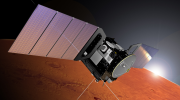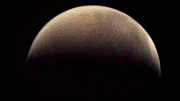This video shows the view of Mars Express from the Earth before, during and after the Curiosity landing. It demonstrates perfectly why we need to use a method called ‘store and forward’ to get the recording of the descent back to Earth.
At the start and end of the video, you can see Mars Express’ big 1.6-m High Gain Antenna (the grey circle on the front of the spacecraft) pointed right at us. We need that to be pointed at us to be able to talk to Mars Express from Earth.
Unfortunately, to support the landing of Curiosity, we need to point our Melacom antennas at the incoming lander, and they’re fixed perpendicular to the High Gain antenna. That’s why during the middle of the video you see the spacecraft turn the High Gain Antenna away from us – it’s so it can get the best possible view of the incoming lander.
In order to relay the recording of the descent, we store the data in our on-board memory – a bit like saving a picture to the memory card on your digital camera.
We have 12 Gigabits of on-board memory, which might sound small compared to your home computer, but it’s plenty of space for what we need. Once we turn back to Earth, we can tell the spacecraft to forward the recorded data back to Earth, just like plugging in your camera and downloading the results from the memory card. In fact, due to the criticality of the Curiosity recording, we’ll transmit it to Earth three times to make sure it reaches us safely.
So when you’re watching the landing tomorrow, note that’s why it’ll take us a bit of time to swing the spacecraft around and dump the recorded data to ground. The JPL orbiter Mars Reconnaissance Orbiter will do the same thing and so will experience a similar delay.
In contrast, the live relay from Mars to Earth will be provided by JPL’s venerable Mars Odyssey orbiter, the oldest spacecraft currently operating around Mars. It uses a different mode, called ‘bent pipe’, where it takes the incoming data and ‘bends’ it around and blasts it back towards Earth more or less simultaneously.
If all goes according to plan, this direct relay will be NASA’s first confirmation of a successful landing, and the detailed recordings made in ‘store and forward’ by the other two orbiters will follow shortly after to provide us a full picture of this historic landing.




Discussion: no comments